RBI Annual Report 2021-22: Highlights
In its annual report that has been released by the Reserve Bank of India (RBI), the central bank has highlighted that the Indian economy will most likely bounce back despite the present global risks.
What are the various key highlights of this report?
- Fake currency: In 2020-21, counterfeit notes saw a decline but in 2021-22 counterfeit notes witness a 10.7 per cent increase. Rs 500 denomination fake currencies rose by 102 per cent in 2021-22. Also, fake Rs 2,000 notes increased by 55 per cent. According to the annual report of the RBI, the total Fake Indian Currency Notes that were detected in the banking sector were 6.9 per cent at RBI and 93.1 per cent at other banks across the country.
- Future Growth: The RBI has stressed that future growth would be conditioned if the supply-side bottlenecks are addressed, and monetary policy is calibrated accordingly to bring down inflation and boost capital spending.
- Impact of Russia-Ukraine Crisis: Due to the Russia-Ukraine crisis, the world economy is in the doldrums and it was already battered due to the multiple waves of the pandemic which disrupted logistics and supply chain. The crisis also elevated inflation across the globe as the price of metals, crude oil, and fertilisers skyrocketed.
- Bank Frauds: The report highlighted that bank frauds in terms of value more than halved in 2021-22, despite the instances of fraud increasing.
- Economic Recovery: The Indian economy can recover from the pandemic in 2021-22, even though it has faced constant interruptions by a second and third wave.
- Monetary Policy: The RBI will be following a nuanced approach keeping in mind the inflation and high commodity prices and will be calibrating the monetary accordingly to ensure that there is adequate liquidity to support the needs of the country’s productive sectors. The monetary policy remains accommodative to spread the roots of recovery while being vigilant so that the inflation remains within target.
- Transfer of Surplus: In 2021-22, the RBI transferred a lower surplus of Rs 30,307.45 crore to the government as compared to Rs 99,122 crore in the previous year.
- Inflation: During the year 2021-22, inflation spiked as there were repetitive supply shocks. The Russia-Ukraine crisis caused a spike in commodity prices, thus, increasing global inflation.
- Indian Economy: According to the report, the country’s economy is relatively in a better place to recover.
- FinTech: The RBI has been encouraging innovation but is also factoring in the emerging risks that arise from the FinTech segment. The involvement of Big Techs in the BFSI sector brings along a systemic risk.
- GDP Estimates: The monetary policy of the RBI has revised the real GDP GDP growth for 2022-23 to 7.2 percent. This is a 60 basis points decline from the predictions it made pre-war. The GDP has been downgraded mainly due to higher oil prices affecting private consumption and higher imports due to which net exports have reduced.
To address the above issues, RBI is looking to balance regulation with innovation, without compromising on risk management principles.
Month: Current Affairs - May, 2022
Category: Economy & Banking Current Affairs - 2024


